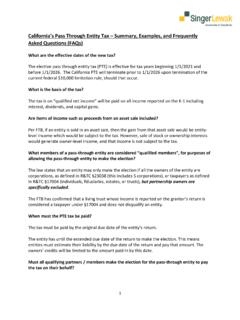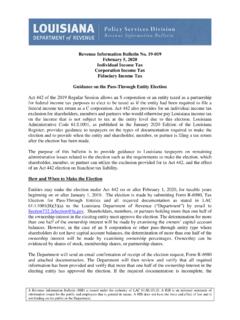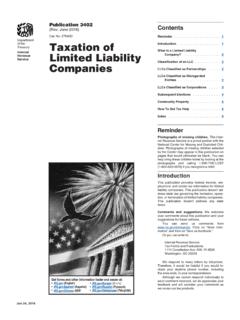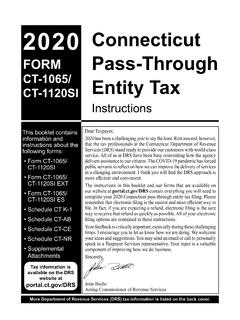Transcription of (Rev. December 2020) - IRS tax forms
1 Userid: CPMS chema: instrxLeadpct: 100%Pt. size: Draft Ok to PrintAH XSL/XMLF ileid: .. ns/I2553/201712/A/XML/Cycle05/source(Ini t. & Date) _____Page 1 of 6 11:56 - 2-Dec-2017 The type and rule above prints on all proofs including departmental reproduction proofs. MUST be removed before for form 2553(Rev. December 2017) election by a Small Business CorporationDepartment of the TreasuryInternal Revenue ServiceSection references are to the Internal Revenue Code unless otherwise DevelopmentsFor the latest information about developments related to form 2553 and its instructions , such as legislation enacted after they were published, go to methods for a corporation ( entity ) to request relief for a late S corporation election , ESBT election , QSST election , or corporate classification election are in effect.
2 See Relief for Late Elections. General InstructionsPurpose of FormA corporation or other entity eligible to elect to be treated as a corporation must use form 2553 to make an election under section 1362(a) to be an S corporation. An entity eligible to elect to be treated as a corporation that meets certain tests discussed below will be treated as a corporation as of the effective date of the S corporation election and doesn t need to file form 8832, entity Classification income of an S corporation generally is taxed to the shareholders of the corporation rather than to the corporation itself. However, an S corporation may still owe tax on certain income. For details, see Tax and Payments in the instructions for form 1120S, Income Tax Return for an S May ElectA corporation or other entity eligible to elect to be treated as a corporation may elect to be an S corporation only if it meets all the following is (a) a domestic corporation, or (b) a domestic entity eligible to elect to be treated as a corporation, that timely files form 2553 and meets all the other tests listed below.
3 If form 2553 isn t timely filed, see Relief for Late Elections, has no more than 100 shareholders. You can treat an individual and his or her spouse (and their estates) as one shareholder for this test. You can also treat all members of a family (as defined in section 1361(c)(1)(B)) and their estates as one shareholder for this test. For additional situations in which certain entities will be treated as members of a family, see Regulations section (e)(3)(ii). All others are treated as separate shareholders. For details, see section 1361(c)(1). only shareholders are individuals, estates, exempt organizations described in section 401(a) or 501(c)(3), or certain trusts described in section 1361(c)(2)(A).For information about the section 1361(d)(2) election to be a qualified subchapter S trust (QSST), see the instructions for Part III.
4 For information about the section 1361(e)(3) election to be an electing small business trust (ESBT), see Regulations section (m). For guidance on how to convert a QSST to an ESBT, see Regulations section (j)(12). If these elections weren t timely made, see Rev. Proc. 2013-30, 2013-36 173, available at # has no nonresident alien has only one class of stock (disregarding differences in voting rights). Generally, a corporation is treated as having only one class of stock if all outstanding shares of the corporation's stock confer identical rights to distribution and liquidation proceeds. See Regulations section (l) for isn t one of the following ineligible bank or thrift institution that uses the reserve method of accounting for bad debts under section insurance company subject to tax under subchapter L of the corporation that has elected to be treated as a possessions corporation under section domestic international sales corporation (DISC) or former has or will adopt or change to one of the following tax tax year ending December natural business ownership tax tax year elected under section 52-53-week tax year ending with reference to a year listed other tax year (including a 52-53-week tax year)
5 For which the corporation establishes a business details on making a section 444 election or requesting a natural business, ownership, or other business purpose tax year, see the instructions for Part shareholder consents as explained in the instructions for column sections 1361, 1362, and 1378, and their related regulations for additional information on the above parent S corporation can elect to treat an eligible wholly owned subsidiary as a qualified subchapter S subsidiary. If the election is made, the subsidiary's assets, liabilities, and items of income, deduction, and credit generally are treated as those of the parent. For details, see form 8869, Qualified Subchapter S Subsidiary To Make the ElectionComplete and file form 2553:No more than 2 months and 15 days after the beginning of the tax year the election is to take effect, orAt any time during the tax year preceding the tax year it is to take this purpose, the 2-month period begins on the day of the month the tax year begins and ends with the close of the Dec 02, 2017 Cat.
6 No. 49978 NPage 2 of 6 Fileid: .. ns/I2553/201712/A/XML/Cycle05/source11:5 6 - 2-Dec-2017 The type and rule above prints on all proofs including departmental reproduction proofs. MUST be removed before before the numerically corresponding day of the second calendar month following that month. If there is no corresponding day, use the close of the last day of the calendar 1. No prior tax year. A calendar year small business corporation begins its first tax year on January 7. The 2-month period ends March 6 and 15 days after that is March 21. To be an S corporation beginning with its first tax year, the corporation must file form 2553 during the period that begins January 7 and ends March 21. Because the corporation had no prior tax year, an election made before January 7 won t be 2.
7 Prior tax year. A calendar year small business corporation has been filing form 1120 as a C corporation but wishes to make an S election for its next tax year beginning January 1. The 2-month period ends February 28 (29 in leap years) and 15 days after that is March 15. To be an S corporation beginning with its next tax year, the corporation must file form 2553 during the period that begins the first day (January 1) of its last year as a C corporation and ends March 15th of the year it wishes to be an S corporation. Because the corporation had a prior tax year, it can make the election at any time during that prior tax 3. Tax year less than 2 1/2 months. A calendar year small business corporation begins its first tax year on November 8.
8 The 2-month period ends January 7 and 15 days after that is January 22. To be an S corporation beginning with its short tax year, the corporation must file form 2553 during the period that begins November 8 and ends January 22. Because the corporation had no prior tax year, an election made before November 8 won t be for Late ElectionsThe following two sections discuss relief for late S corporation elections and relief for late S corporation and entity classification elections for the same entity . For supplemental procedural requirements when seeking relief for multiple late elections, see Rev. Proc. 2013-30, section filing form 2553 for a late S corporation election , the corporation ( entity ) must enter in the top margin of the first page of form 2553 FILED PURSUANT TO REV.
9 PROC. 2013-30. Also, if the late election is made by attaching form 2553 to form 1120S, the corporation ( entity ) must enter in the top margin of the first page of form 1120S INCLUDES LATE election (S) FILED PURSUANT TO REV. PROC. 2013-30. The election can be filed with the current form 1120S if all earlier forms 1120S have been filed. The election can be attached to the first form 1120S for the year including the effective date if filed simultaneously with any other delinquent forms 1120S. form 2553 can also be filed for a Late S Corporation election Filed by a CorporationA late election to be an S corporation generally is effective for the tax year following the tax year beginning on the date entered on line E of form 2553. However, relief for a late election may be available if the corporation can show that the failure to file on time was due to reasonable request relief for a late election , a corporation that meets the following requirements must explain the reasonable cause for failure to timely file the election and its diligent actions to correct the mistake upon discovery.
10 This information can be provided on line I of form 2553 or on an attached corporation intended to be classified as an S corporation as of the date entered on line E of form 2553; corporation fails to qualify as an S corporation (see Who May Elect, earlier) on the effective date entered on line E of form 2553 solely because form 2553 wasn t filed by the due date (see When To Make the election , earlier); corporation has reasonable cause for its failure to timely file form 2553 and has acted diligently to correct the mistake upon discovery of its failure to timely file form 2553; 2553 will be filed within 3 years and 75 days of the date entered on line E of form 2553; corporation that meets requirements (1) through (4) must also be able to provide statements from all shareholders who were shareholders during the period between the date entered on line E of form 2553 and the date the completed form 2553 is filed stating that they have reported their income on all affected returns consistent with the S corporation election for the year the election should have been made and all subsequent years.

















